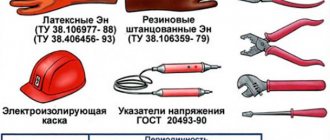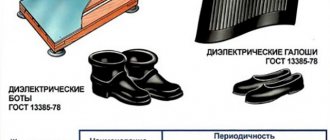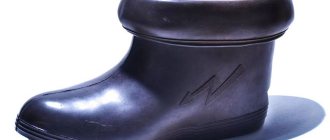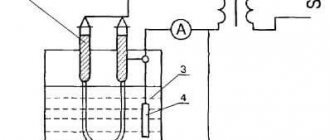| NAME OF WORKS | UNITS MEAS. | QTY | UNIT PRICE |
| Testing dielectric bot | pair | 1 | RUB 245.00 |
| Testing dielectric galoshes | pair | 1 | RUB 245.00 |
Tel.
manager: +7 (495) 777-21-32 E-mail for ordering: [email protected]
The laboratory of high-voltage electrical measurements of MOSENERGOTEST LLC tests dielectric boots and galoshes, which are used to work on high-voltage electrical installations. Tests are carried out by qualified employees with experience and the necessary approvals.
A specialized high-voltage stand is used for testing; after the test, stamps are placed on the shoes indicating the date of the maximum permissible voltage and the next test. Based on the results of the inspection, protocols are drawn up, which are provided along with the tested protective equipment. The frequency of testing rubber dielectric boots and galoshes is from 1 to 3 years.
Why check dielectric shoes
Special dielectric footwear includes dielectric galoshes and dielectric boots. They are used to protect against electric shock when working in closed and open high-voltage electrical installations. To perform such work, it is permitted to use rubber dielectric overshoes and boots, manufactured in accordance with GOST, free of defects and passed high-voltage tests.
Dielectric boots are suitable for working on electrical installations of all voltage classes, and dielectric overshoes can only be used for working on electrical installations with voltages up to 1000 V. Dielectric shoes differ in their protective properties and are designated by letter indices: En - dielectric overshoes, Ev - dielectric boots.
In order not to confuse dielectric galoshes and boots with other rubber shoes, they are produced in a different color. Dielectric boots have flaps, their height is at least 16 cm.
Purpose and types
Dielectric rubber boots GOST 13385-78 are a type of protective footwear that do not conduct electric current even when exposed directly. They are used to protect a person from the effects of step voltage.
Photo - rubber boots
There are two types of such safety shoes:
- Boots;
- Galoshes.
Each of these subspecies differs accordingly in appearance and area of use. The first ones are easily recognized by the upper flap, which serves as protection against liquids penetrating under the surface of simple rubber boots. The size range of dielectric boots has a very wide range - from 292 centimeters to 352. To determine the size, you need to use a special table:
| Shoe size, Russia | 300 | 307 | 315 | 322 | 330 | 337 | 345 |
| Designation on the sole of special models | 40 | 41 | 42 | 43 | 44 | 45 | 46 |
Sizes 39 (292) and 47 (352) are considered rare and most often need to be made to order.
Photo - dielectric boots
Galoshes differ from dielectric boots not only in appearance and height. They can only be used in installations with data up to 1000 Volts. At the same time, special protective boots are used to work in conditions of voltage from 1000 Volts to 2000 Volts.
Photo - galoshes
They are included in the kit for working on powerful electrical installations. Also included in the list:
- Electrical installation tools with insulated handles (wire cutting scissors, screwdrivers, rods, pointers) or any other set;
- First aid kit;
- Belt for attaching devices to the electrician’s body;
- Other precautions: gloves, rubber plates, carpets, socks, glasses.
The manufacturer is obliged to indicate on the surface of the bots their expiration date, production, batch and other parameters. Specifications :
- The thickness of the sole is at least 6 mm;
- Height not less than 16 centimeters (with the lapel turned up);
- Possibility to unfold or roll up the upper part of the boots;
- Inner lining made of durable non-conductive material.
Photo - personal protective equipment
Video: how rubber boots and galoshes are made
Testing times for dielectric galoshes and boots
The technology for testing dielectric shoes is similar to the procedure for testing dielectric gloves and is performed on special equipment in a laboratory. Galoshes and overshoes are placed horizontally in the bath, the water level is within 15-25 mm from the edge of the overshoes and 45-55 mm from the lapels of the overshoes.
The test voltage for checking dielectric boots is 15 kV, for dielectric galoshes - 3.5 kV. The duration of the dielectric shoe test is 1 minute. The current passing through boots should be no more than 7.5 mA, and through overshoes - no more than 2 mA. The frequency of testing dielectric boots is once every 3 years, and overshoes are once a year.
Checking dielectric galoshes
Checking dielectric galoshes is one of the types. In general, there are two types of safety footwear - boots and galoshes. The main difference between these types of shoes is in two main parameters, one of which is appearance, the second is the area of use. Externally, galoshes and boots should look like this: rubber top, rubber grooved sole, textile lining. Boots must be no shorter than 160 mm and have cuffs. The boots can be recognized by the flap at the top; it is this that protects them and the wearer from liquids. The sizes of dielectric bots are quite varied (in stores you can find from 292 to 352 cm). To determine the size you need, a correspondence table was invented. Some sizes are very rare and require pre-order (*39 and *47). Dielectric galoshes are checked strictly by specialists from electrical laboratories.
Dielectric boots and galoshes protect against step stress and are considered additional PPE. Galoshes are used when working with devices of 1000V or less, and boots - over 1000V. The process of testing dielectric galoshes, as well as shoes and boots, occurs by applying a voltage of 15 kV, and testing dielectric galoshes - a voltage of 3.5 kV. Test time is one minute. For galoshes, the flowing current does not exceed 2 mA, for boots - 7.5 mA. It is under such conditions that the products are considered to have passed the tests and are ready to fulfill their protective mission.
Dielectric rubber overshoes comply with the approved GOST 13385-78 and are shoe models, the main distinguishing feature of which is protection from electric current during the direct action of current on an object. This type of footwear is used to protect employees from the effects of step voltage in electrical installations of any type and voltage, including overhead power lines.
The standards and frequency of checking dielectric galoshes are given in the “Instructions for the use and testing of protective equipment used in electrical installations” (СО 153-34.03603-2003).
Rubber dielectric galoshes and boots are used on powerful electrical installations. The list of things included in the set of items for performing services should include:
— a set of electrical installation tools with special protective handles (rods, pliers and other devices); — first aid equipment (first aid kit); — a belt for attaching things necessary for work to a specialist’s clothing; - gloves; - plates or carpets with an insulating function; — coverings and linings, caps; - special socks; - glasses.
Specifications:
— sole thickness: more than 6 millimeters; — height: 16 cm (the entire height is taken into account, including the boot lapel); — the ability to use the upper part of the boots, increasing the protection zone; — the presence of an internal lining made of protective material: if this becomes unusable or peels off, it is necessary to carry out repairs, or it is better to buy new dielectric boots. Protection first!
Professional inspection of dielectric galoshes and boots
Rubber safety shoes have a shelf life of about a year, less often a little more - about 16 months. Before starting work, it is imperative to conduct a shoe test for current conductivity.
Checking dielectric galoshes includes the same points as testing special insulated gloves: - preparation of special equipment; — water test: immersion in a container by 45-46 mm (boots) and 25-26 mm (galoshes); — the upper part should not be immersed in water; — tests are carried out at a power of 15 kW; — to assess the effectiveness of the protective plan, just one minute is enough; — ideally, dielectric overshoes are checked before each use, but experts say that three times a year will be enough.
Testing of dielectric galoshes is usually carried out in specially equipped laboratories or at home. A routine inspection of shoes saves you from the need to frequently carry out tests, which assumes: - the absence of mechanical damage on the surface in the form of cracks, scratches and other deformations; - cleanliness of shoes; - the lining should not peel off.
Methods for using protective galoshes and bots
Such elements of workwear are used in conditions of increased danger. This applies primarily to boots, socks and dielectric gloves. The main condition for their use is the absence of dust and moisture in the room. Otherwise, the effectiveness of this type of clothing is reduced, and significantly. It may be dangerous.
How to use electricians' shoes correctly. - Wear exclusively over cleaned casual shoes. If it is not possible to wear galoshes (or sneakers), wear rubberized socks. — If the room where you work is under step voltage, be sure to lay special mats or rubber plates as a temporary floor covering - in this case you will protect yourself from the effects of current and will be completely safe. - Pay attention to the expiration date - it is indicated on the sole; In addition, the manufacturer also indicates the basic operating conditions for the bots. — Due to the nature of the conditions, 2 main groups are distinguished: for operation at temperatures from -15 to 40 degrees; for use at -50 - +80. - In addition to shoes, do not forget about other means of insulating protection - devices such as socks and gloves. Prices for checking rubber dielectric bots
You can purchase dielectric special shoes in a regular shopping center that sells electrical appliances.
The price of such accessories is regulated by the following factors: - brand; - degree of protection.
All products must have appropriate certification, fire resistance and fire protection, as well as voltage (the maximum level of protection is indicated).
Max-energo also performs the following types of work:
- Checking dielectric gloves
- Checking the dielectric mat
- Insulating tool testing
- Testing insulating rods
- Voltage indicator tests
Also, interesting articles can be found in our groups on social networks using hashtags # Testing dielectric shoes # Testing dielectric shoes # Testing dielectric bots # Testing dielectric galoshes # Testing dielectric bots
Rules for using dielectric shoes
In the electrical installation room there should be several pairs of dielectric galoshes and boots of different sizes. Before using safety shoes, they should be checked carefully. Special protective equipment and electrical boots are prohibited from being used if:
- There is no high voltage test stamp.
- There are mechanical damages.
- There are cracks on the sole.
- The lining has peeled off.
- There is dirt on the shoes.
How to use bots
Boots, dielectric gloves and socks are used in high-risk areas. At the same time, the building should not be wet or dusty, otherwise the effectiveness of the boots is significantly reduced. Step-by-step instructions on how to use electrician shoes:
- They are worn only over regular shoes. Make sure your boots are clean first. If it is not possible to wear the usual sneakers or galoshes, then use rubberized socks;
- If the room is under step voltage, then before walking on the floor, you need to spread special mats or rubber plates on it - this will protect against high current;
- The manufacturer indicates on the sole not only the expiration date, but also the operating conditions. All boots and galoshes are divided into two groups: those that are used at temperatures from -15 to 40 degrees, and -50 to +80;
- It is advisable to use all possible insulating devices together: gloves, socks and shoes.
Checking protective galoshes and bot
The stationary laboratory "MOSENERGOTEST" performs high-quality tests of personal protective equipment for working with high-voltage equipment. Checking dielectric boats and galoshes meets all the requirements of regulatory documents, current norms and rules. Before testing, a thorough inspection of the shoes is carried out.
If there are defects, boots and galoshes are considered unusable and removed from testing. If the external inspection is positive, electrical and mechanical characteristics are checked. We carry out testing of dielectric shoes in a laboratory equipped with the most modern equipment.
Price overview
You can buy dielectric boots at any electrical appliance store; their price depends on the brand and level of protection provided (for example, Rostov special store). Sales are also carried out in factories where protective measures are produced.
| City | Cost of rubber molded dielectric boots |
| St. Petersburg | 535 |
| Almaty | 540 |
| Moscow | 540 |
| Ekaterinburg | 530 |
| Krasnodar | 535 |
| Chelyabinsk | 535 |
| Samara | 535 |
Before purchasing, always check the certificate of conformity of the bots, their fire rating and the voltage at which they provide maximum protection.










